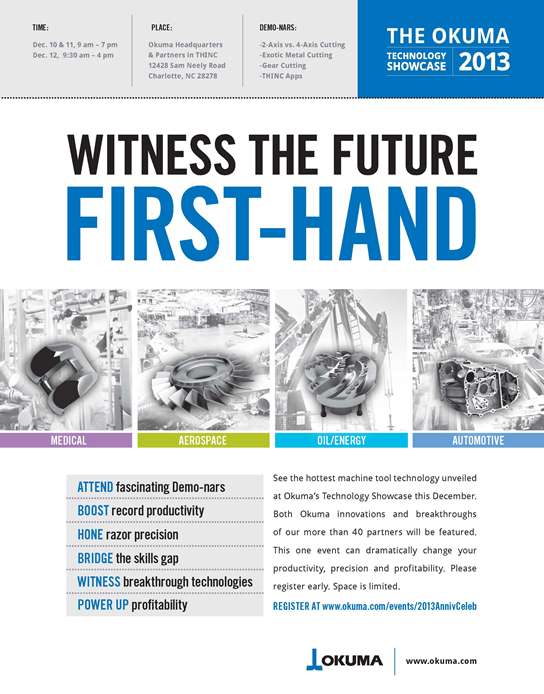
Okuma America Corp holds the 2013 Technology Showcase event on Dec. 10-12, 2013, in Charlotte N.C. The event gives attendees the opportunity to witness the latest technology via hands-on demonstrations, and allows them to learn how this new technology can be applied to their specific manufacturing challenges.
The demonstrations are relevant to attendees from a variety of industries, with cutting demonstrations using composite material, Inconel, titanium and carbon fibers, on a variety of machines, including the LB-3000 EX, MULTUS B750, MB-4000H, PALLETACE (flexible manufacturing system), and the VTR-160A double-column turning center.
Members of Partners in THINC will demonstrate how peripheral equipment, such as tooling, gaging, workholding, automation and CNC software, can be integrated with Okuma technology to improve productivity. This 3-day event features a wide array of learning opportunities, allowing each attendee to customize the experience. Featured areas include:
- Proprietary Okuma technologies, such as collision avoidance system, thermal active stabilizer, Machining-Navi, Super-NURBS, Turn-Cut and 5-axis auto tuning system;
- Drawing-to-part demonstrations show the process of taking a concept from design to a shippable part, for a variety of applications utilizing technology from Partners in THINC;
- Lights-out manufacturing using an automation cell on a CNC lathe;
- Hard turning materials hardened to 60HRC and harder on an LB-3000EX lathe;
- Gear cutting on a 2-axis lathe with milling function and on a multifunction lathe;
- Various automation cells ranging from bar feeding a lathe, to robot loading/unloading, to a full flexible manufacturing system (FMS) with three integrated horizontal machining centers;
- More than 10 educational demonars each day on a variety of topics such as Caron Engineering Adaptive Software (TMAC), Renishaw Equator, Real Time Connectability, Machining-Navi, Turn-Cut and PALLETACE (FMS).
In addition to the multitude of machines and cutting demonstrations, and in honor of the 50th anniversary of the OSP control, the Okuma THINC-OSP-P300 control is available for hands-on trials.
Related Glossary Terms
- computer numerical control ( CNC)
computer numerical control ( CNC)
Microprocessor-based controller dedicated to a machine tool that permits the creation or modification of parts. Programmed numerical control activates the machine’s servos and spindle drives and controls the various machining operations. See DNC, direct numerical control; NC, numerical control.
- flexible manufacturing system ( FMS)
flexible manufacturing system ( FMS)
Automated manufacturing system designed to machine a variety of similar parts. System is designed to minimize production changeover time. Computers link machine tools with the workhandling system and peripherals. Also associated with machine tools grouped in cells for efficient production. See cell manufacturing.
- gang cutting ( milling)
gang cutting ( milling)
Machining with several cutters mounted on a single arbor, generally for simultaneous cutting.
- hard turning
hard turning
Single-point cutting of a workpiece that has a hardness value higher than 45 HRC.
- lathe
lathe
Turning machine capable of sawing, milling, grinding, gear-cutting, drilling, reaming, boring, threading, facing, chamfering, grooving, knurling, spinning, parting, necking, taper-cutting, and cam- and eccentric-cutting, as well as step- and straight-turning. Comes in a variety of forms, ranging from manual to semiautomatic to fully automatic, with major types being engine lathes, turning and contouring lathes, turret lathes and numerical-control lathes. The engine lathe consists of a headstock and spindle, tailstock, bed, carriage (complete with apron) and cross slides. Features include gear- (speed) and feed-selector levers, toolpost, compound rest, lead screw and reversing lead screw, threading dial and rapid-traverse lever. Special lathe types include through-the-spindle, camshaft and crankshaft, brake drum and rotor, spinning and gun-barrel machines. Toolroom and bench lathes are used for precision work; the former for tool-and-die work and similar tasks, the latter for small workpieces (instruments, watches), normally without a power feed. Models are typically designated according to their “swing,” or the largest-diameter workpiece that can be rotated; bed length, or the distance between centers; and horsepower generated. See turning machine.
- milling
milling
Machining operation in which metal or other material is removed by applying power to a rotating cutter. In vertical milling, the cutting tool is mounted vertically on the spindle. In horizontal milling, the cutting tool is mounted horizontally, either directly on the spindle or on an arbor. Horizontal milling is further broken down into conventional milling, where the cutter rotates opposite the direction of feed, or “up” into the workpiece; and climb milling, where the cutter rotates in the direction of feed, or “down” into the workpiece. Milling operations include plane or surface milling, endmilling, facemilling, angle milling, form milling and profiling.
- turning
turning
Workpiece is held in a chuck, mounted on a face plate or secured between centers and rotated while a cutting tool, normally a single-point tool, is fed into it along its periphery or across its end or face. Takes the form of straight turning (cutting along the periphery of the workpiece); taper turning (creating a taper); step turning (turning different-size diameters on the same work); chamfering (beveling an edge or shoulder); facing (cutting on an end); turning threads (usually external but can be internal); roughing (high-volume metal removal); and finishing (final light cuts). Performed on lathes, turning centers, chucking machines, automatic screw machines and similar machines.






